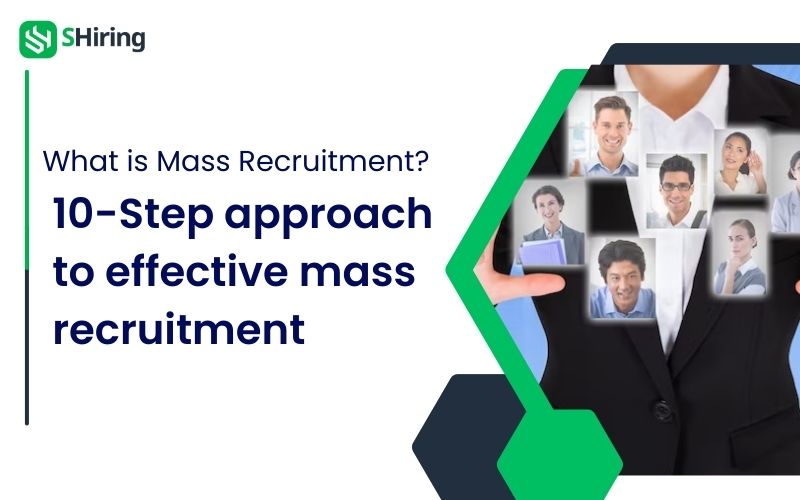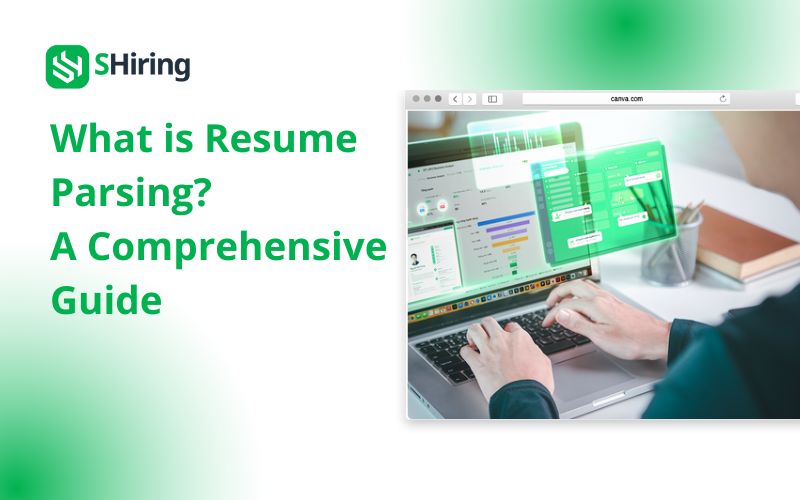With the advent of the competitive labor market, the construction and promotion of an Employer Branding has become a key tool to attract and retain talent. Employer Branding is not only there to help shape a positive image of the workplace of a company but is also very important in terms of increasing the effectiveness and productivity of the employees. For next year 2024 is just around the corner and, among many other things… Effective Employer Branding strategies will enable companies to achieve it. In this article, let SHiring help you with the employer branding concept and suggest to you the top 6 employer branding strategies for an attractive, reliable recruitment brand.
What is Employer Branding?
Employer Branding is the process of building and promoting the image and reputation of a company as an attractive and ideal workplace environment. It is a crucial strategy for attracting and retaining talent, as well as creating a dynamic, innovative, and efficient work environment. To successfully implement an Employer Branding strategy, businesses need to focus on the following aspects:
- Company values: Identify and communicate what makes the company an attractive workplace, such as culture, core values, career development opportunities, benefits, etc., to potential candidates.
- Work environment: Build a positive, supportive, and reliable work environment where employees can thrive and contribute.
- Brand communication: Utilize communication channels and marketing tools to promote and build a positive image of the organization, including websites, social media, events, and other media to portray the organization as a desirable employer.
- Candidate Experience: Create a great experience for employees through recruitment processes, training and development, benefits, and incentive programs.
- Consistency: Ensure consistency between the company’s image and reality, as well as between what the company portrays and employees’ actual experiences.
The importance of creating employer branding
Today’s businesses face numerous challenges in attracting and retaining talent. One effective solution to this problem is building a strong employer brand. A strong employer brand brings many benefits to businesses. .
Enhancing candidate attraction and long-term commitment
According to a survey by LinkedIn, 75% of candidates research a company’s brand before applying for a job. A strong employer brand attracts the attention of top candidates who are seeking an ideal work environment. When employees feel proud to work for the company and trust its employer brand, they are more likely to have long-term commitment. Additionally, according to LinkedIn, up to 83% of employees would leave their current company if offered a job by a more reputable employer. Furthermore, employees at companies with strong employer brands tend to have a lower turnover rate in the first 6 months compared to other companies.
Boosting effectiveness and job productivity
By implementing an effective employer branding strategy, businesses can attract and retain talented individuals who are competent and passionate about their work. Talented and long-term committed employees contribute to higher work efficiency, thereby enhancing the productivity and effectiveness of the entire organization. Working for a company with a strong employer brand, employees feel proud and motivated to contribute their best, thereby fostering creativity and continuous improvement, ultimately helping the business achieve its goals more efficiently.
Optimizing recruitment and training costs
Attracting suitable candidates from the outset helps businesses save costs on recruitment and training. Similarly, having long-term committed employees also yields similar results. According to LinkedIn, companies with strong employer brands attract over 50% more high-quality candidates, have recruitment processes that are 1 to 2 times faster, and reduce recruitment costs by 50%.
Gaining a competitive advantage
A strong employer brand is a crucial competitive factor. When a business has a good employer brand, they attract potential candidates while enhancing the company’s image and reputation in the market.
Who is in charge of employer branding?
When discussing employer branding, many tend to only think about the role of the human resources department. While HR plays a crucial part in building employer branding, the reality is that employer branding is not simply what a company wants to convey to candidates or job seekers. Employer branding accurately reflects the culture and true values of the business. And employer branding is shaped by various components within the organization, not just the HR department.
- Firstly, the founders – business owners – CEOs, and senior leadership play a vital role in setting strategic vision and defining the core values that the company aims for.
- Secondly, department managers who have a direct impact on leadership, evaluation, training, and the development of employees’ professional as well as skill competencies.
- Additionally, the HR department acts as a link in fostering relationships among personnel within the company and developing appropriate HR policies.
- Finally, the marketing and communications team play a crucial role in presenting the image, story, and people of the company through various social media channels, events, etc.
However, if each department operates individually or according to its own ideas, it will not be possible to build a strong employer brand for the business. To have a strong employer brand, all departments need to collaborate and work together smoothly.
5 steps to build an effective employer branding for businesses
As mentioned above, we can see the important role of this strategy in the development of an organization’s human resources. To implement an effective employer branding and strategy, below are 5 basic steps that businesses should take:
Step 1: Set specific goals for the employer branding strategy
First of all, businesses need to clearly define specific goals for their employer branding strategy. These goals may include increasing brand recognition, attracting high-quality candidates, reducing employee turnover, or improving current employee satisfaction. Clearly defining goals will help businesses have clear direction and easily evaluate strategic effectiveness.
Step 2: Conduct research and build an ideal candidate persona
To attract the right candidates, businesses need to build ideal candidate portraits. This persona includes characteristics such as the candidate’s skills, experience, personal values, and career goals. This helps businesses better understand their target audience, thereby designing appropriate and attractive recruitment campaigns.
Below is a summary of criteria that can help you identify your ideal candidate profile:
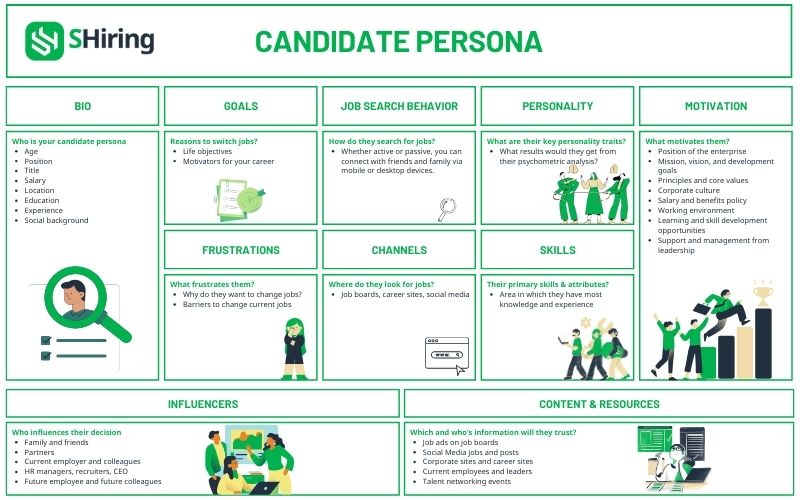
Nguồn: Talynlyft
Step 3: Determine EVP
To establish a successful Employer Branding strategy, you need to answer the following questions:
- Why did current employees decide to join your business?
- Why are they still attached to the company until now?
- What factors make them interested in working at your business from an employer’s perspective?
The answers to these questions will help you build your HR value proposition (EVP – Employee Value Propositions). EVP is the value that businesses commit to bringing to employees. This is a core factor that helps businesses stand out in the eyes of candidates. EVP can include factors such as career development opportunities, a good working environment, attractive remuneration policies, and corporate culture. Clearly defining an EVP helps businesses convey a consistent and strong message to potential candidates
A complete EVP includes 5 main elements:
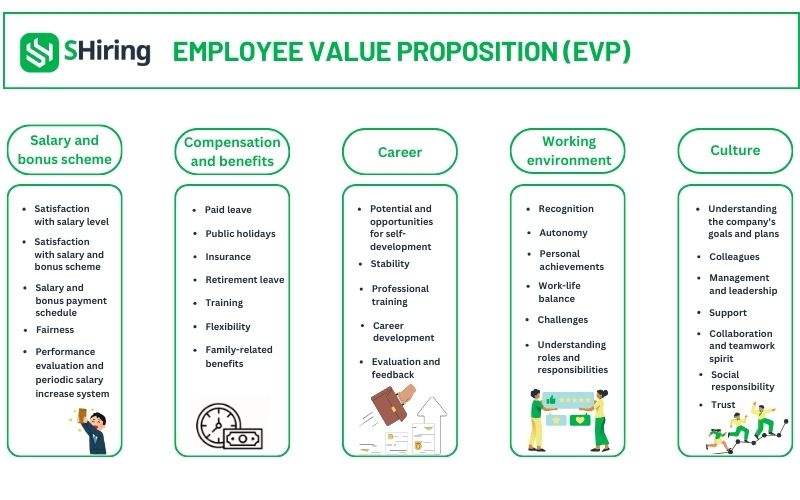
Nguồn: Talynlyft
Step 4: Choose a means of promoting the employer branding
Choosing the right promotional channel helps your business’s message reach the right audience. Popular channels include recruitment websites, social networks, job fairs and specialized websites. Each channel has its own advantages and disadvantages, so businesses need to consider carefully to choose the channel that suits their goals and candidates.
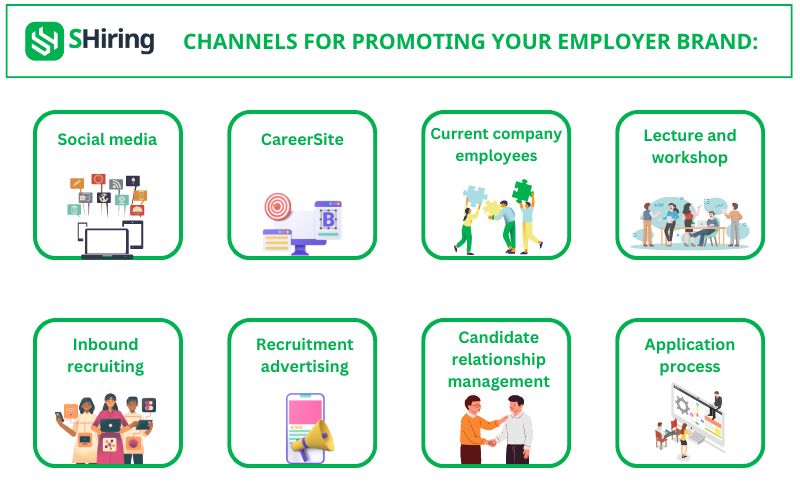
Nguồn: Talynlyft
Step 5: Measure effectiveness Employer Branding strategy
Finally, businesses need to measure and evaluate the effectiveness of their employer branding strategy. Metrics to track include candidate quantity and quality, candidate-to-employee conversion rate, employee satisfaction, and feedback from candidates about the recruitment process. Based on measurement results, businesses can adjust strategies to achieve the highest efficiency.
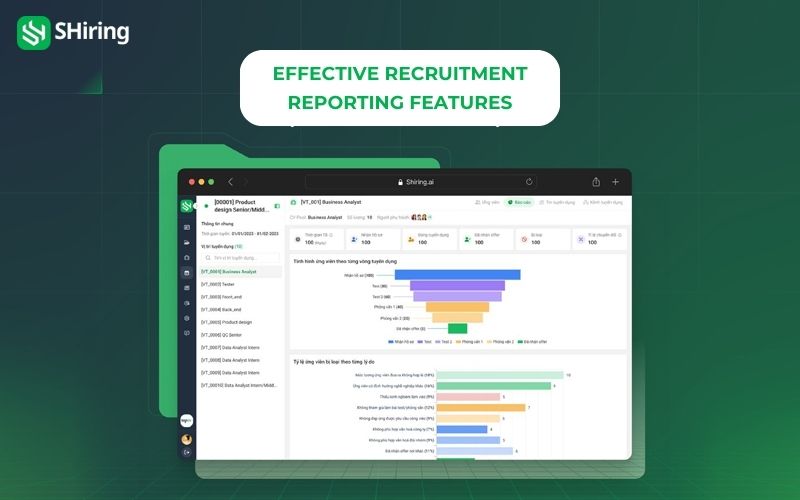
SHiring – High-performance recruitment management software for businesses. SHiring not only provides comprehensive human resources management solutions but also has the ability to measure and report important indicators in the recruitment process, including:
- Report recruitment status for each position with indicators such as conversion rate, rate of candidates interviewed, rate of candidates who rejected offers, rate of candidates hired, rate of candidates who were rejected. type and total number of rejected CVs.
- The chart illustrates the number of candidates converted through each recruitment round, from receiving applications, taking tests, interviewing to sending offers and recruiting.
- Detailed report on reasons for rejecting CVs and candidates.
6 Successful employer branding strategies for businesses in 2024
In the context of increasingly fierce competition for talent, building an attractive employer branding has become a top priority for businesses. A comprehensive strategy that includes many aspects will help businesses build a solid position in the labor market, attract and retain the best talent.
Analyze company culture
The starting point of each strategy is analyzing the company culture. Culture creates characteristics, creating a different business. What are the core values that permeate each employee? What is the attractive beauty that makes talented people admire and desire to become part of the organization? This can only be discovered when we listen carefully to the people who are dedicating their energy and enthusiasm here. Listen to employee voices through surveys and dialogues to clearly grasp the existing culture. From there, identify the strengths that need to be promoted and the weaknesses that need to be overcome to build an ideal working environment where talented people aspire to stay.
Once you understand your own business, the next job is to evaluate the current position of the company’s employer branding in the labor market. Because only by correctly acknowledging the current situation can we chart the right path to conquer new heights. Then outline the EVP value statement – the benefits that the business can bring to candidates and employees. It could be open career opportunities, a fair promotion path, a cohesive culture that honors personal values, or simply a professional, dynamic but no less cozy working environment.
Implement a clear and engaging content strategy
Once we have clearly identified the destination, we will deploy attractive and clear content strategies to truly represent the brand’s nature. From work, build a professional recruitment website with detailed business information, work culture and recruitment positions; to writing a compelling job description that fully portrays the challenges and benefits of the position. Create authentic, intimate storytelling content about employee experiences, affirming the core values of the business. Then the brand language spreads everywhere, attracting potential candidates with the same desire and passion.
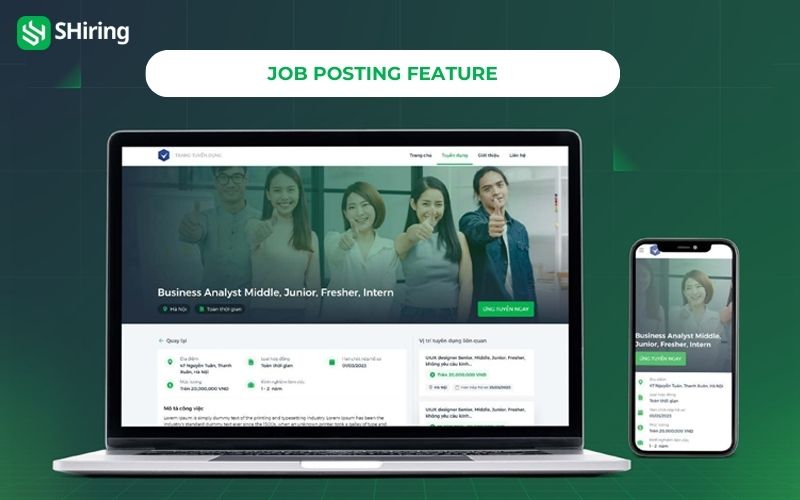
SHiring provides CareerSite – a separate recruitment website for businesses. Allows you to create unlimited job postings with customizable job description templates, automatically posted to CareerSite. Each job posting has its own sharing link. Candidates send their CV directly to the application form for each position. With this feature, businesses can enhance their employer branding, reach more candidates and manage job postings effectively.
Employee Advocacy – Brand ambassador
At the same time, set up an Employee Advocacy program that turns each employee into a “brand ambassador”, conveying authentic recruitment messages. Recognize and reward the best individuals and groups to encourage diffusion. Build emotional bonds between people who are going through many ups and downs together. From there, they voluntarily ignite the fire of enthusiasm when sharing their work experiences with friends, relatives and the online community.
Take advantage of social networks
A brand only becomes strong when it is present everywhere its target audience is using, and nothing is more familiar to the younger generation than social networks. Connect and interact with potential candidates to promote your brand and attract them with valuable content about culture and career opportunities. Vivid stories with creative images and videos will attract candidates’ attention.
Plan to attract and develop talented candidates and internal employees
Strategy to attract and develop talent plays an important role in the sustainable success of a business. First, businesses need to propose attractive values such as remuneration, promotion opportunities and a dynamic working environment to attract and retain talents. Next, building a recruitment plan associated with the brand will help create a strong impression in the minds of potential candidates.
After successful recruitment, businesses need to build an effective Onboarding process including introduction and training activities to help new employees integrate quickly. At the same time, businesses must always ensure transparency and clarity in all information and transactions with candidates and employees to maintain good and long-term relationships.
Finally, to retain and develop talent, businesses need to provide learning and career development opportunities such as training courses, financial support, mentoring and coaching programs so that employees can hone their skills.
Testing and evaluation process
Once fully implemented, the testing and evaluation process will help businesses review the actual effectiveness of their efforts. Monitor brand feedback and reviews on social networks and recruitment review forums. Analyze talent retention rates to evaluate the effectiveness of company culture. Combined with recruitment source tracking to clearly understand candidates’ job search behavior. And most importantly, measure employee satisfaction to continuously improve the working environment for the better.
Only when implementing each strategy synchronously with enthusiasm and perseverance can businesses build a truly attractive and sustainable employer branding. To become the top choice of talented candidates, thereby gaining a competitive advantage in the race to attract high-quality human resources in 2024. Because the success of a business is the sum of its individuals. Talented people come together to create passion.
Above is important information that managers need to know to build a strong employer branding, thereby attracting and retaining talent for the company. Discover SHiring’s experience now to create a professional Career Site, optimizing your Employer Branding process.
In conclusion, Employer Branding is a critical aspect of talent management in today’s competitive business environment. By implementing effective strategies, businesses can build a strong employer brand that attracts, retains, and nurtures top talent, positioning them for sustained success in 2024 and beyond.


